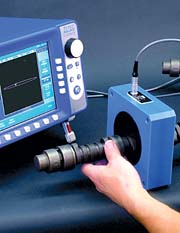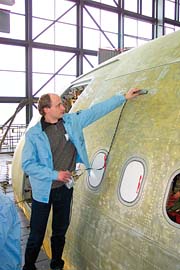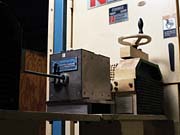

There is little doubt about the impact eddy current has had on production. In fact, this diverse technology may have only one flaw-it may be too successful.
Richard Fisher, product manager at Advanced Kiffer Systems (AKS, Cleveland), knows firsthand the "perils" of successful eddy current applications. AKS specializes in eddy current testing for the tube, bar and wire industry and has performed component inspection with eddy current, looking for defects in shafts, rods, bearings and valves, primarily for the automotive industry.
Then there was his company's specialty machinery endeavor, also for the automotive industry. "We did camshaft inspection, looking at valves for heat-treat cracks or casting flaws," Fisher says. The company's approach was to use eddy current probes to scan small surface areas of the automated machines. If the probe detected a disturbance, it would trigger an alarm and defective connective parts would be rejected. At the same time, manufacturers used the data to try to improve processes.
"In fact, the camshaft inspection machines we provided for the automotive industry were only used for about three years," Fisher says. "They were able to improve the process to a point where they no longer needed our inspection equipment."
"We ‘successed' ourselves right out of that business," he says.
Not that his company is abandoning eddy current-far from it. In fact, promising new applications are emerging, and Kiffer and others anticipate a rosy future for this nondestructive test inspection technique.

New Uses
One area of growth is being fueled by applying eddy current to new market segments.
Zetec Inc. (Issaquah, WA) got its start in eddy current by inspecting tubing, particularly in nuclear power plants, says Dan DeVries, vice president, component test and aerospace. But, as his title indicates, the company's focus has expanded into looking at aircrafts.
"One of the things that drives the aircraft business as well as the nuclear business is that regulatory agencies require eddy current to be used for inspection," he says. "Some growth is being built into regulations, which helps drive the eddy current industry."
Other growth is occurring in component testing, with the goal of improving the quality in new parts. That has meant some challenges, and changes, for eddy current.
For airplane inspection, "It's typically somebody grabbing a small handheld instrument, walking on the wing of the plane, and physically running an eddy current probe along the part they want to inspect," DeVries explains. On a production line, on the other hand, "We're learning the key is actually integrating eddy current into the manufacturing system, the material- handling system." That, in turn, has created a demand for better communication between the eddy current instruments and the network of existing systems within the production line.
In short, eddy current is evolving into a more sophisticated analytical tool, one that can store data and be integrated into a suite of other electronics. "It's not just helping us identify a good part or a bad part," says DeVries. "It's becoming a matter of: ‘Why is this a bad part, and what process upstream has created this problem? Was it an induction heating coil-did it stop working? Is the tool that did the machining dull?'"
DeVries says that a big push for manufacturers is to figure out how to use the eddy current data. For example, one of Zetec's projects is to inspect aircraft wheels. That means each wheel and the inspection data captured from that wheel needs to be linked into a statistical database that provides inspection dates and findings from every inspection, enabling manufacturers to conduct comparative analysis over time. "That's where we see the growth in eddy current," DeVries says. At the same time, he and his colleagues at Zetec are also developing eddy current instruments for inspecting heat treating and alloys of components. "We're seeing a lot of growth in this area," he says, "more so than the traditional area of looking at cracks."
Zetec is also exploring other possibilities. Eddy current is limited primarily to surface inspections of metallic objects. For a deeper look, manufacturers have to turn to technologies such as ultrasonics. "There's a real promise in figuring out how to integrate those two technologies," DeVries says.
Another possibility is embedding eddy current sensors into structures. "It might be possible to embed the sensors into the places where you'd normally look for cracks or fatigue," DeVries suggests.
An Array of Choices
Zetec and other companies are also looking into yet another eddy current frontier: array technology.
Traditional eddy current uses a small, single probe or five- to six-probe instruments, which limits users to inspecting only a small area at a time. Instruments with 10, 20, 30 or even hundreds of arrays, on the other hand, would allow for broader inspections and permit easier scans of custom shapes.
Marc Grenier, an engineer with R/D Tech (Quebec, Canada) says his company is using conventional eddy current probes, but combining them in greater numbers. The probes, operating simultaneously, allow inspectors to cover a large area in a single, comprehensive pass. "The inspection is much faster," he says, "and determining the defect size and shape is also much easier, compared to doing a raster scan with a single probe."
The company is also combining arrays with the inspection system's imaging capabilities. "So now the users do not have to look at an impedance plane, but just at a C-scan view-a color display that lets them see the size of a flaw in length, height and depth," Grenier says.
The hurdles are many, Grenier admits. One hurdle is to combine many individual probe coils without interference from individual sensors. "Cross-talk effect is a big challenge to resolve in making an array," he says. "We also have to make sure the equipment can drive such a complex probe. And there's also a bigger flow of data to collect. We wanted to make sure the equipment can record all this data and display it in real time, without being overwhelmed by the amount of data."
Like Zetec, R/D is moving its eddy current applications beyond the nuclear industry and into aerospace.
"The aerospace market is quite difficult," says Grenier, "because most of the time we're looking at defects that are quite deep under the surface, compared to what we previously did, which was look for surface defects." But he is convinced that despite the difficulties of deeper inspections, eddy current will be up to the task. The company is focusing on inspecting plane fuselages, specifically lap joints, with an eye toward detecting corrosion and cracks in fasteners. The emphasis is on maintenance right now. As Grenier points out, current aircraft inspection procedures are based on conventional eddy current techniques. "So there's a big need to have this technology accepted and to have it written into procedures, so that it can be used in the maintenance of the airplane." But down the road, he says, it's possible the array technology will also be used in the construction process.
Grenier is also looking beyond the aerospace industry. "We recently did a study for automotive manufacturers to find corrosion in critical areas of the car structure," he says.
"We are finding that there are many places where conventional eddy current is used where array technology can bring improvement," Grenier continues. Not only do arrays allow for faster, easier sweeps of an area, but they permit better views of complex shapes. Traditional eddy current typically requires a robot and several modes of access to place the probe correctly. With the array, the probe can be shaped to follow the profile of the part. Moreover, conventional eddy probe inspections can be duplicative, with the same area requiring multiple passes with the probe. With the array technology, only one pass is needed.
Despite these advances, no one is sounding the death knell for traditional eddy current. Conventional methods will always remain. "Both techniques will be complementary," Grenier says.
On an aircraft fuselage, for example, an array may be used for a quick inspection over the surface. But this wider probe may not permit easy access to a specific area; users would then turn to a conventional probe. "We make sure that our equipment can handle both the array and the conventional," Grenier says. "And because we use roughly the same kind of sensor, the user does not have to be retrained. It's quite easy to switch from one to the other."
Conventional Tools Evolving
Conventional eddy current technology is also evolving. Grenier sees an increased emphasis of combined signal frequencies. Multifrequencies have long been in use for testing tubes in the nuclear industry, but are only now starting to penetrate other market segments. "There is the possibility to do more signal processing on small, portable systems which would permit wider applications," he says.
The sensors themselves may undergo change as well. The technology originally used coils-copper wire was wound into various shapes to generate the AC field and to read the signal emanating from the surface. But in recent years magneto-resistive and Hall effect sensors have become more sensitive, to the point where they often can match the sensitivity of the coils. Grenier foresees a day when the newer-not to mention cheaper-sensors become more common.
Fisher, of Advanced Kiffer Systems, spies opportunity in the cold heading industry, in which wire or rod comes off a reel, is run into a heading machine to be cropped into shorter lengths, sent through a series of dies and then hammered into a specific shape. Problems can occur if there are defects in the heading wire itself, which usually results in a crack or a split in the part.
"What we're doing is inspecting the rod material with what we call an encircling coil," Fisher says. "The material passes through an inspection coil that circulates eddy current, and we look for disturbances. If we see a flaw or defect in the wire, we track that through the heading machine. The computerized system knows where the head is relative to the crop [where the piece is cut], and it knows the number of transfer stations there are in there as well-it knows how many times the part got hammered before it comes out as its final shape. We track that through the machine and activate a diverter gate at the output, so the part is automatically rejected into a dump chute." The upside is that the manufacturer can reject a part when it costs only pennies, as opposed to doing so later in the process, after it has become a highly value-added item.
Eddy current inspection on the input side of heading machines is a new area for Advanced Kiffer Systems. Fisher adds that this use of eddy current is new in general. "There have been some machines to check the heads of bolts, looking for cracks or splits. But that's after the fact." Moreover, these inspections are difficult, he maintains, because it requires custom handling equipment. Varying part shapes require multiple probes. If the part size changes, then the tooling needs to be changed as well. But with Advanced Kiffer's method, Fisher says, "It's one size fits many."
Like his colleagues in the field, Fisher admits the challenges of developing new eddy current applications. Other devices, such as induction heating devices used to preheat the material or to anneal it, often operate on similar frequencies, interfering with the eddy current.
Vibration interference can cause anomalies in the readings. Too much shaking or banging can create false signals, in addition to damaging parts or the inspection coils. "This is supposed to be a noncontact inspection method, so if the coil touches the part, then you've got a problem," Fisher says. "An occasional hit is OK, but if it actually wears the coil out, then it gets to be an expensive proposition."
Manufacturers are trying to find a balance between cost and the need to catch and eliminate defects. On the one hand, the cost of some newer eddy current solutions may limit their applications-even if the technology works, it may simply be too expensive to implement. On the other hand, as Fisher points out, manufacturers and their supplies want zero defects-an impossibility, to be sure. "But that's what they're striving for," he says. And as long as that remains the case, eddy current, in all its forms, will likely have a place at the inspection table.
Benefits